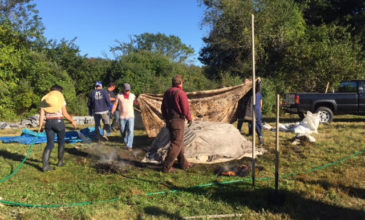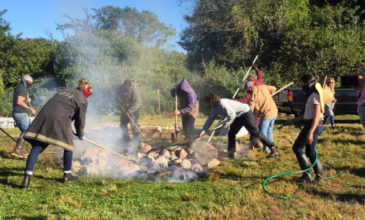The Clambake, a spectacular American culinary event specific to our region, originated on the coast of southeastern Massachusetts. The Wampanoag Indians, from Narragansett Bay to Cape Cod, Martha’s Vineyard, and Nantucket are said to have passed the tradition on for generations. For centuries before modern development, shell mounds, or “middens,” towering over men, were excavated along shorelines; the middens pin point exact locations of ancient feasting of locally grown shellfish. One such location is at the head of the Westport River or the “Head of Westport.” Westport, my home town, is a southeastern Massachusetts fishing and farming town steeped in local tradition and pride. So, naturally my friends and I have adopted the clambake tradition from generations of our families before us. This year was our 11th annual clambake hosted for 150+ of our closest family and friends.
The bake starts a week before the big day; ordering food, collecting friends to help, gathering pallets for burning, and digging up equipment for serving, display and ambiance. The site of the clambake shifts from various friends’ (or parents’) back yards. The bake is always in an open field off in the woods, a perfect spot for camping and debauchery. The night before, out-of-towners converge at one of our homes and we prep and cook the stuffed quahogs. Early the morning of the bake, we build a bonfire over a bed of round, cannonball- like stones. As the fire heats up, our chowder starts to cook and the crew heads to the River to collect rock weed. With a truck bed full of rock weed we head back to the bake site for set up, all the while stoking the fire. Parents and kids trickle in all afternoon, and at 4:00 we prep to face the coals, dressing up in our fireman jackets, handkerchiefs, gardening gloves and boots.
-



The fire is ready to be pulled away from the rocks, and the clams ready to be cooked! A bottle of brown liquid is passed among friends. We cover our faces with wet handkerchiefs, and head into the smoke, raking and shoveling the coals away from the stones. The action is fast and methodic, workers in the middle racking coal toward a center pile, and shovelers heaving from the outer edges of the line up. The rock weed is thrown on the rocks quickly, to retain as much heat as possible to steam the food. Then comes the food. Wooden crates with metal mesh bottoms hold little necks, mussels, lobster, stuffed quahogs, brown bread, potatoes, corn, eggs, onions, and sausages. A friend manning the hose douses a dozen sheet size canvas cloths, and then workers, 2 by 2, drape them over the food. A blue tarp covers the entire rock, seaweed, and food mound to seal in the heat and steam.
Guests enjoy the assortment of beverages and the clam chowder, a recipe perfected by one of our very own.
After an hour of cooking the food is removed from the bake, and arranged buffet style. We feast, turn up the music, and throw pallets on the fire late into the night. The Clambake is the best kind of reunion, it draws friends (and friends of friends) in to support and enjoy the produce of our local waters.
About the Author –
Lucy Snyder is a Designer who works out of Hutker Architects’ Martha’s Vineyard office. She’s spending Thanksgiving in Florida this year, where seafood will surely be on the menu.